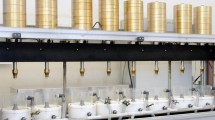Abstract
Objectives
The aim of the present study was to comparatively evaluate the mechanical wear of adhesives used in bonded retainers.
Materials and methods
Eighty mandibular acrylic teeth were included in the study that were divided into 4 different groups based upon the composite used. Each acrylic tooth was bonded with a retainer wire and composite of their respective group (Heliosit, Restofill, Tetric-N-flow, and Filtek Z350 XT). These bonded acrylic teeth were subjected to 3D scan in order to evaluate the volume and surface area of the composite. The 3D scans were recorded using MEDIT 3D scanner. After evaluating, the samples were subjected to brushing with the aid of a custom-made brushing simulator using a toothbrush with soft bristles and toothpaste slurry. The samples were subjected to 1 hr of brushing. These samples were again subjected to 3D scans to evaluate (post-test volume and surface area) and underwent statistical analysis.
Results
The results showed the Heliosit group exhibited the highest mean volume (1.76 mm3) and surface area (4.81 mm2) difference between the pre-test and post-test values whereas the least mean volume difference (1.10 mm3) and surface area difference (3.21 mm2) were seen in the Tetric-N-flow group.
Conclusion
All the four composites underwent change in the mean surface area and volume after being subjected to brushing, suggesting that the composites routinely used for bonding fixed bonded lingual retainers are subjected to changes due to abrasion. The Heliosit group, which showed least filler loading among the 4 composites, exhibited least resistance to wear, whereas the Tetric-N-flow group which had highest filler loading among the composites exhibited highest resistance to wear.
Clinical relevance
The most crucial phase during orthodontic treatment is the retention phase. This phase is responsible for the long-term results of the treatment. The retainers that are placed in the oral cavity are subjected to changes due to oral environment, chemical changes, and mechanical changes. These changes have a direct effect on the retainers, which tend to alter their properties. Thus, the effects of these changes are to be studied thoroughly.
Similar content being viewed by others
Data availability
Not applicable
Abbreviations
- 3D:
-
Three dimensional
- STL :
-
Stereolithography
- mm:
-
Millimeter
References
Riedel RA, Brandt S, Richard A (1976) Riedel on retention and relapse. J Clin Orthod 10:454–72
Cerny R (2001) Permanent fixed lingual retention. J Clin Orthod 35:728–732
Lee RT (1981) The lower incisor bonded retainer in clinical practice: a three year study. Br J Orthod 8:15–18
Reitan K (1967) Clinical and histologic observations on tooth movement during and after orthodontic treatment. Am J Orthod Dentofacial Orthop 53:721–745
Jørgensen KD (1982) In vitro wear tests on macro-filled composite restorative materials. Aust Dent J 27(3):153–8
Sifakakis I, Pandis N, Eliades T, Makou M, Katsaros C, Bourauel C (2011) In-vitro assessment of the forces generated by lingual fixed retainers. Am J Orthod Dentofacial Orthop 139(1):44–8
Zafar M, Nayyer M, Zahid S, Hassan S, Mian S, Mehmood S, Khan A (2018) Comparative abrasive wear resistance and surface analysis of dental resin-based materials. Eur J Dent 12:57
de Moraes RR, Goncalves Lde S, Lancellotti AC, Consani S, Correr-Sobrinho L, Sinhoreti MA (2009) Nanohybrid resin composites: nanofiller loaded materials or traditional microhybrid resins? Oper Dent 34(5):551–557
Johnsen GF, Taxt-Lamolle SF, Haugen HJ (2011) Wear model simulating clinical abrasion on composite filling materials. Dent Mater J 30(5):739–748
Mitra SB, Wu D, Holmes BN (2003) An application of nanotechnology in advanced dental materials. J Am Dent Assoc 134(10):1382–1390
Monfared V, Bakhsheshi-Rad HR, Ramakrishna S, Razzaghi M, Berto F (2021) A brief review on additive manufacturing of polymeric composites and nanocomposites. Micromachines 12(6):704
Scougall-Vilchis RJ et al (2009) Examination of composite resins with electron microscopy, microhardness tester and energy dispersive X-ray microanalyzer. Dent Mater J 28(1):102–112
Rodrigues-Junior SA, Chemin P, Piaia PP, Ferracane JL (2015) Surface roughness and gloss of actual composites as polished with different polishing systems. Oper Dent 40(4):418–429
Acknowledgements
The authors would like to acknowledge the staff, parents, and almighty for their constant support and blessings.
Author information
Authors and Affiliations
Contributions
The complete research and manuscript were scrutinized by all the four authors and suggestions at each level were put forth to improve the efficacy of the study. The study design was planned by Dr Y.N. Sasidhar and was executed by Dr C. Kamala under the guidance of Dr. P. Ujwala. Dr .P. Ujwala and Dr Y.N. Sasidhar scrutinized each sample and made sure that the methodology was carried out in the described manner. The manuscript was written by Dr C. Kamala and reviewed by Dr. P. Ujwala, Dr. Y.N Sasidhar and Dr. B Sudheer. Dr. P. Ujwala has been a constant source of support, guided throughout the research, and her suggestions and inputs helped in executing the research work. Dr. Y.N. Sasidhar has been a rock support throughout the research; his eagle eye vision helped in correcting the minute mistakes during the designing of study, procedure execution, and in the construction of the manuscript.
Corresponding author
Ethics declarations
Ethical approval
Not applicable
Competing interests
Not applicable
Additional information
Publisher's note
Springer Nature remains neutral with regard to jurisdictional claims in published maps and institutional affiliations.
Rights and permissions
Springer Nature or its licensor (e.g. a society or other partner) holds exclusive rights to this article under a publishing agreement with the author(s) or other rightsholder(s); author self-archiving of the accepted manuscript version of this article is solely governed by the terms of such publishing agreement and applicable law.
About this article
Cite this article
Kamala, C., Ujwala, P., Sasidhar, Y.N. et al. A comparative evaluation of mechanical wear of adhesives used for bonded retainers that underwent brushing for 1 hour under 36 mm of linear action, using computer-aided 3D scan—an in vitro study. Clin Oral Invest 27, 5805–5812 (2023). https://doi.org/10.1007/s00784-023-05192-y
Received:
Accepted:
Published:
Issue Date:
DOI: https://doi.org/10.1007/s00784-023-05192-y




